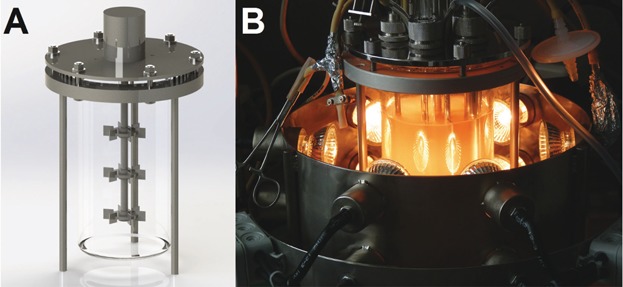Externally illuminated photobioreactors (PBRs) are widely used in studies on the use of prototrophic microorganisms as sources of bioenergy and other photobiotechnology research. In this work, straightforward simulation techniques were used to describe effects of varying fluid flow conditions in a continuous hydrogen-producing PBR on the rate of photofermentative hydrogen production (rH2) by Rhodobacter sphaeroides DSM 158. A ZEMAX optical ray tracing simulation was performed to quantify the illumination intensity reaching the interior of the cylindrical PBR vessel. 24.2 % of the emitted energy was lost through optical effects, or did not reach the PBR surface. In a dense culture of continuously producing bacteria during chemostatic cultivation, the illumination intensity became completely attenuated within the first centimeter of the PBR radius as described by an empirical three-parametric model implemented in Mathcad. The bacterial movement in chemostatic steady-state conditions was influenced by varying the fluid Reynolds number. The "Computational Fluid Dynamics" and "Particle Tracing" tools of COMSOL Multiphysics were used to visualize the fluid flow pattern and cellular trajectories through well-illuminated zones near the PBR periphery and dark zones in the center of the PBR. A moderate turbulence (Reynolds number = 12,600) and fluctuating illumination of 1.5 Hz were found to yield the highest continuous rH2 by R. sphaeroides DSM 158 (170.5 mL L-1 h-1) in this study.

Externally illuminated photobioreactors (PBRs) are widely used in studies on the use of prototrophic microorganisms as sources of bioenergy and other photobiotechnology research. In this work, straightforward simulation techniques were used to describe effects of varying fluid flow conditions in a continuous hydrogen-producing PBR on the rate of photofermentative hydrogen production (rH2) by Rhodobacter sphaeroides DSM 158. A ZEMAX optical ray tracing simulation was performed to quantify the illumination intensity reaching the interior of the cylindrical PBR vessel. 24.2 % of the emitted energy was lost through optical effects, or did not reach the PBR surface. In a dense culture of continuously producing bacteria during chemostatic cultivation, the illumination intensity became completely attenuated within the first centimeter of the PBR radius as described by an empirical three-parametric model implemented in Mathcad. The bacterial movement in chemostatic steady-state conditions was influenced by varying the fluid Reynolds number. The "Computational Fluid Dynamics" and "Particle Tracing" tools of COMSOL Multiphysics were used to visualize the fluid flow pattern and cellular trajectories through well-illuminated zones near the PBR periphery and dark zones in the center of the PBR. A moderate turbulence (Reynolds number = 12,600) and fluctuating illumination of 1.5 Hz were found to yield the highest continuous rH2 by R. sphaeroides DSM 158 (170.5 mL L-1 h-1) in this study.
